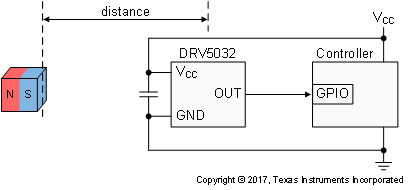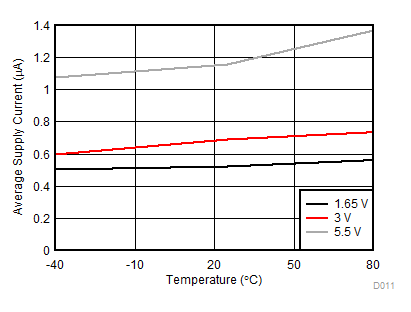SLVSDC7F April 2017 – February 2022 DRV5032
PRODUCTION DATA
- 1 Features
- 2 Applications
- 3 Description
- 4 Revision History
- 5 Device Comparison
- 6 Pin Configuration and Functions
- 7 Specifications
- 8 Detailed Description
- 9 Application and Implementation
- 10Power Supply Recommendations
- 11Layout
- 12Device and Documentation Support
- 13Mechanical, Packaging, and Orderable Information
3 Description
The DRV5032 device is an ultra-low-power digital-switch Hall effect sensor, designed for the most compact and battery-sensitive systems. The device is offered in multiple magnetic thresholds, sampling rates, output drivers, and packages to accommodate various applications.
When the applied magnetic flux density exceeds the BOP threshold, the device outputs a low voltage. The output stays low until the flux density decreases to less than BRP, and then the output either drives a high voltage or becomes high impedance, depending on the device version. By incorporating an internal oscillator, the device samples the magnetic field and updates the output at a rate of 20 Hz, or 5 Hz for the lowest current consumption. Omnipolar and unipolar magnetic responses are available.
The device operates from a VCC range of 1.65 V to 5.5 V, and is packaged in a standard SOT-23, TO-92 and small X2SON.
| PART NUMBER | PACKAGE | BODY SIZE (NOM) |
|---|---|---|
| DRV5032 | SOT-23 (3) | 2.92 mm × 1.30 mm |
| X2SON (4) | 1.10 mm × 1.40 mm | |
| TO-92 (3) | 4.00 mm × 3.15 mm |
 Typical Schematic
Typical Schematic Current Consumption of 5-Hz
Version
Current Consumption of 5-Hz
Version